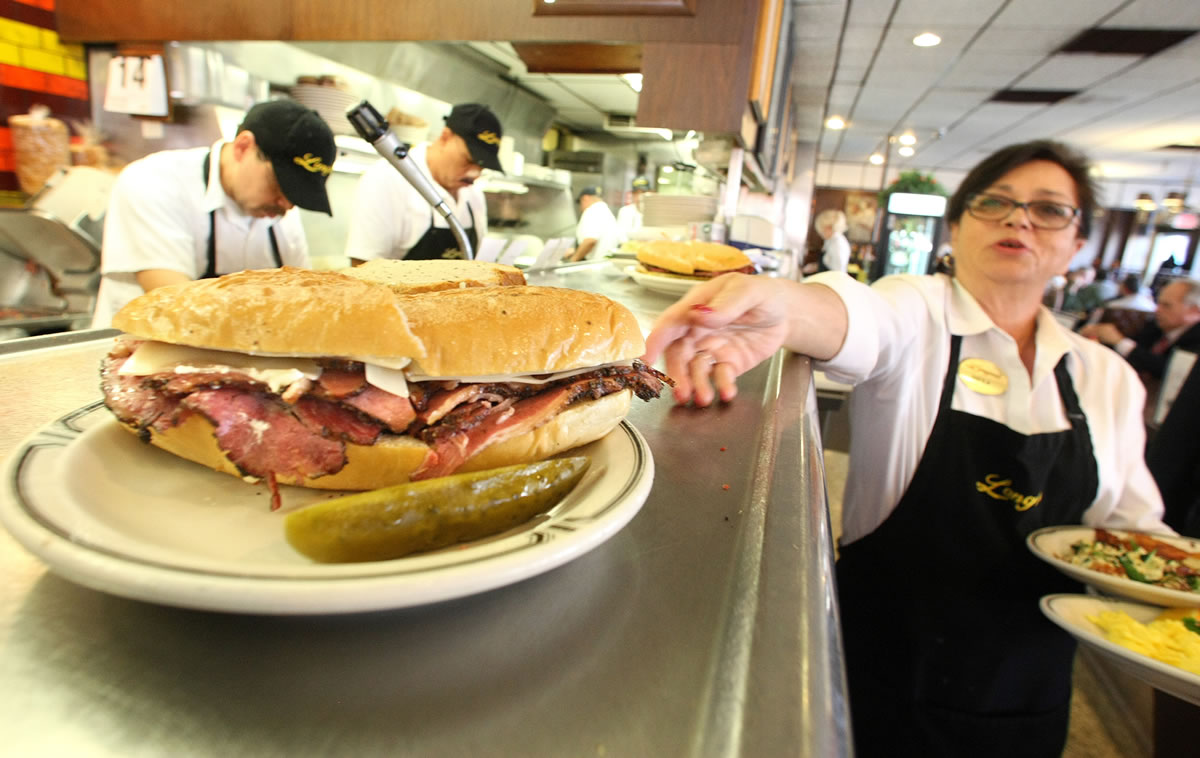When Junior’s Deli closed in late December, longtime customers lined up for a last, nostalgic nosh at the 53-year-old Los Angeles-area institution.
But Brian Won’s main reaction was “meh.”
“The food was unremarkable,” said the West Los Angeles IT specialist, 32, who visited to use up a Groupon voucher. “Given that there are so many good places to eat in L.A., I have a really hard time saying yes to that.”
Increasing apathy, particularly from younger patrons, has driven traditional Jewish delicatessens from their pinnacle last century. The decline seems to be accelerating partly because of health concerns over the schmaltz-spread fare and partly because bagels are now available in every supermarket.
Add sides of restaurant-industry slump and rising lease rates, and even local landmarks aren’t immune.
In the past three months, three long-standing emporiums of corned beef and matzo around the country have closed.
Faced with aging clientele and a difficult economy, Ashkenaz Delicatessen in Chicago went dark in November and was replaced by a seafood joint called Da Lobsta. In Manhattan, high rent and the recession led to the closure of 75-year-old Stage Deli.
“People don’t open up new delis anymore because it’s very, very difficult to do,” said Marian Levine, owner of Stage’s longtime rival, Carnegie Deli in Manhattan.
In the first half of the 20th century, several thousand Jewish delis were operating in New York. But as Jewish immigration to the East Coast ebbed after World War II and younger generations splintered into the suburbs, the number has shrunk to a few dozen.
Southern California has suffered the same troubles bedeviling delis in the east. Jerry’s Famous Deli closed its Costa Mesa, Calif., branch this spring and laid off dozens of employees. After years spent dishing up pickle-flanked masses of pastrami to the likes of Bruce Willis and Mel Brooks, Junior’s closed following a rental spat with its landlord.
“There’s nothing that can bring back the centrality of the deli in either Jewish life or American life,” said Ted Merwin, an expert on Jewish culture and a professor at Dickinson College in Pennsylvania. “There’s no way they’re going to survive in the numbers they once did.”
Merwin thinks Los Angeles’ thriving ethnic food scene is partly to blame.
“It used to be that delis had a very loyal customer base who would come in every day,” he said. “But now, with the restaurant industry in L.A. exploding with thousands and thousands of new options, why would they?”
Jewish delis are also part of a restaurant sector that has struggled overall since the recession. Sales at family sit-down restaurants stagnated between 2007 and 2011 and grew a stingy 0.5 percent last year, according to research firm Mintel.
The stress showed at Junior’s, where revenue slumped 20 percent in the past three years as food costs surged, the result of unpredictable weather affecting crops and animal feed. Rents are also rising, especially in urban centers, making property difficult to afford for all but the largest chain delis.
Art’s Deli owner Harold Ginsburg, 52, said he’s had to cut back on non-food items at the Los Angeles store: having fewer employees on call, trimming insurance costs and sending delivery cars to the cheapest gas stations.
At Langer’s in Los Angeles, owner Norm Langer jacked up menu prices 4 percent this month. But the increase “wasn’t enough to compensate for the rising cost of food,” which he said has soared as much as 9 percent in the past 18 months.
Fish prices have “gone crazy,” said Langer, whose father launched the business 65 years ago. The deli hasn’t sold barbecued cod in five years, when the seafood went from being a third cheaper than lox to a third more expensive and supply became unpredictable.
Beef prices, inflated by the severe summer drought and mass exports to Japan, aren’t helping. Neither are skyrocketing premiums for medical benefits for the eatery’s unionized workers, Langer said.
And with diners still wary after the downturn, even a pastrami sandwich as revered as his struggles when it costs more than $20 a person after a beverage, a side dish, tax and tip, Langer said.
“At Quiznos, you can buy a sandwich for lunch for $5,” he said.



